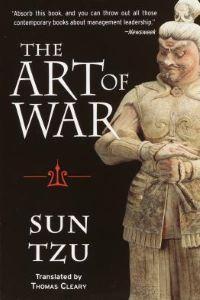“Sun Tzu said: The art of war is of vital importance to the State. It is a matter of life and death, a road either to safety or to ruin.”
This is one of the oldest books that still survives today. The Art of War, attributed to Sun Tzu, a Chinese military strategist from the 5th century BC. He’s one of the greatest tacticians of all times, and as a result, much military training and strategy have been based on this book.
It’s made up of thirteen chapters, each chapter dedicated to a different type of warfare. It contains detailed explanations of weapons, discipline, and intelligence operations. The teachings Sun Tzu wrote in this novel are considered one of history’s best examples of military tactics and strategy.
Summary
The novel goes through the main thirteen factors involved in warfare. The first chapter covers the five basic aspects of the way, seasons, leadership, management and terrain. Chapter two deals with how the economy and engagements affect the success of war. The third chapter covers the five factors needed to succeed. Chapter four is the importance of defence and chapter five is the advantage of good timing and creativity. The sixth chapter covers the possible opportunities the environment provides. Chapter seven is about the dangers of direct attacks. The eight chapter covers the need for flexibility and the ninth focuses on the different situations an army can find themselves in. Chapter ten is about different areas of resistance; distance, barriers, and dangers. The eleventh and twelfth chapters describe different campaigning situations and the use of weapons. Chapter thirteen, the final chapter, covers the importance of information sources and intelligence.
Commentary
The Art of War is one of the most influential war books of all times.
Praise
- It has had a tremedous affect on military operations, even today. The book has inspired many famous generals and soldiers and a lot of successful battles have been attributed to the tactics discussing in this novel.
- Other career sectors have also taken tactics from it. A lot of corporate office settings apply these strategies amongst their management. Some Japanese companies even make their managers read this book before they can accept the job.
- It has many famous quotes and motivational lines. This novel is considered a must read for a reason, as it can be incredibly inspirational for all sorts of battles. It promotes peace but still provides fighting solutions to ensure you win.
Critique
- If you’re not involved in the army or an office, it can be a very boring read. The chapters are laid out in a way similar to poetry. Each ‘verse’ has a different lesson, and dozens of these paragraphs combine to form the chapters.
- The translation from Chinese into English does the original novel no justice at all. It loses most of its meaning and a lot of metaphors don’t directly translate. As a result, it’s a complete failure in comparison to the first version and doesn’t read easily at all.
- The messages vary from vague and minimalist to over-domineering and controlling. It’s not a particularly nice book, and there are not many everyday situations where you should apply these militaristic tactics.
Recommendations
Overall, I’d give Sun Tzu’s The Art of War one out of five stars. It isn’t that interesting and much of it seemed to drag. If you are a school or college student reading this for class, then continue reading. If not, then I’d only recommend this novel to those with an interest in warfare or military tactics.

Want to read it for yourself? You can find it in:
- Waterstones
- WHSmith
- Book Outlet
- Scholastic
- Harper Collins
Prefer to listen to it instead? You can find it on:
Find me on Goodreads or StoryGraph!
